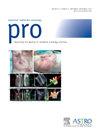世界卫生组织(WHO)2 级脑膜瘤放射外科和放射治疗病例指南》,来自放射外科协会。
IF 3.4
3区 医学
Q2 ONCOLOGY
引用次数: 0
摘要
目的:脑膜瘤是中枢神经系统最常见的原发性肿瘤。目前的治疗方法包括手术切除并辅以或不辅以放射治疗(RT)、确定性 RT 和观察。然而,用于治疗WHO 2级脑膜瘤(约占所有脑膜瘤的20%)患者的放射剂量、分次和边缘尚未明确定义,而且由于缺乏随机数据,决定最佳治疗方式可能具有挑战性:本手稿介绍了3例WHO 2级脑膜瘤患者的病例,并描述了大体全切除、次全切除和先前照射区域内复发肿瘤后的治疗方案。治疗建议由放射外科协会的 9 位中枢神经系统放射肿瘤学和神经外科专家汇编而成,报告了大多数治疗指南的共识:结果:常规和立体定向 RT 都是治疗 WHO 2 级脑膜瘤的选择。大多数WHO 2级脑膜瘤的前瞻性数据涉及较大的边缘。立体定向放射手术/低分次立体定向 RT 不太适合这种情况。传统的分次放射治疗至少要达到 59.4 Gy,这被认为是标准的治疗方法,同时利用术前和术后成像来评估疾病的范围和可能的骨质受累情况。经过仔细讨论后,立体定向放射手术/低分次立体定向 RT 可能会在无法耐受漫长的标准常规分次治疗疗程、既往接受过 RT 治疗或残留肿瘤较小的患者中发挥作用。然而,还需要更多的研究来确定最佳方法:本文基于病例对现有文献进行评估,旨在为2级脑膜瘤的治疗提供范例,并给出常规和立体定向RT的范例。本文章由计算机程序翻译,如有差异,请以英文原文为准。
A Case-based Guide for World Health Organization (WHO) Grade 2 Meningioma Radiosurgery and Radiation Therapy from The Radiosurgery Society
Purpose
Meningiomas represent the most common primary tumor of the central nervous system. Current treatment options include surgical resection with or without adjuvant radiation therapy (RT), definitive RT, and observation. However, the radiation dose, fractionation, and margins used to treat patients with WHO grade 2 meningiomas, which account for approximately 20% of all meningiomas, are not clearly defined, and deciding on the optimal treatment modality can be challenging owing to the lack of randomized data.
Methods and Materials
In this manuscript, 3 cases of patients with WHO grade 2 meningiomas are presented with descriptions of treatment options after gross total resection, subtotal resection, and previous irradiation. Treatment recommendations were compiled from 9 central nervous system radiation oncology and neurosurgery experts from The Radiosurgery Society, and the consensus of treatment recommendations is reported.
Results
Both conventional and stereotactic RT are treatment options for WHO grade 2 meningiomas. The majority of prospective data in the setting of WHO grade 2 meningiomas involve larger margins. Stereotactic radiosurgery/hypofractionated stereotactic RT are less appropriate in this setting. Conventionally fractionated RT to at least 59.4 Gy is considered standard of care with utilization of preoperative and postoperative imaging to evaluate the extent of disease and possible osseous involvement. After careful discussion, stereotactic radiosurgery/hypofractionated stereotactic RT may play a role for the subset of patients who are unable to tolerate the standard lengthy conventionally fractionated treatment course, for those with prior RT, or for small residual tumors. However, more studies are needed to determine the optimal approach.
Conclusions
This case-based evaluation of the current literature seeks to provide examples for the management of grade 2 meningiomas and give examples of both conventional and stereotactic RT.
求助全文
通过发布文献求助,成功后即可免费获取论文全文。
去求助
来源期刊

Practical Radiation Oncology
Medicine-Radiology, Nuclear Medicine and Imaging
CiteScore
5.20
自引率
6.10%
发文量
177
审稿时长
34 days
期刊介绍:
The overarching mission of Practical Radiation Oncology is to improve the quality of radiation oncology practice. PRO''s purpose is to document the state of current practice, providing background for those in training and continuing education for practitioners, through discussion and illustration of new techniques, evaluation of current practices, and publication of case reports. PRO strives to provide its readers content that emphasizes knowledge "with a purpose." The content of PRO includes:
Original articles focusing on patient safety, quality measurement, or quality improvement initiatives
Original articles focusing on imaging, contouring, target delineation, simulation, treatment planning, immobilization, organ motion, and other practical issues
ASTRO guidelines, position papers, and consensus statements
Essays that highlight enriching personal experiences in caring for cancer patients and their families.
 求助内容:
求助内容: 应助结果提醒方式:
应助结果提醒方式:


